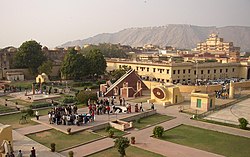Jantar Mantar
The Jantar Mantar is an equinoctial sundial, consisting of a gigantic triangular gnomon with the hypotenuse parallel to the Earth's axis. On either side of the gnomon is a quadrant of a circle, parallel to the plane of the equator. The instrument is intended to measure the time of day, correct to half a second and declination of the Sun and the other heavenly bodies.
There were five Jantar Mantars in India, of which the largest is in Jaipur which features many instruments along with the world's largest stone sundial.[1] At present only four Jantar Mantar exist, as the Jantar Mantar at Mathura was torn down just before Revolt of 1857. The Vrihat Samrat Yantra is a sundial that is claimed to give the local time to an accuracy of 2 seconds.[2] It is a UNESCO World Heritage Site.
History[edit | edit source]
In the early 18th century, Maharaja Jai Singh II of Jaipur constructed five Jantar Mantar in total, in New Delhi, Jaipur, Ujjain, Mathura and Varanasi; they were completed between 1724 and 1735.
The Jantar have like Samrat Yantra, Jai Prakash, Ram Yantra and Niyati Chakra; each of which are used to for various astronomical calculations. The primary purpose of the observatory was to compile astronomical tables and to predict the times and movements of the sun, moon and planets.[3]
List Of Instruments:
- Samrat Yantra
- Jai Prakash Yantra
- Disha Yantra
- Rama Yantra
- Chakra Yantra
- Rashiwalya Yantra
- Dingash Yantra
- Utaansh Yantra
Name[edit | edit source]
The name "Jantar Mantar" is at least 200 years old, finding a mention in an account from 1803.[4] However, the archives of Jaipur State, such as accounts from 1735 and 1737–1738, do not use this as Jantra, which in the spoken language is corrupted to Jantar.[4] The word Jantra is derived from yantra, instrument, while the suffix Mantar is derived from mantrana meaning consult or calculate.[4] The words jantar and mantar (or yantra and mantra) mean calculation instrument.
See also[edit | edit source]
- Jantar Mantar in Jaipur
- Jantar Mantar in New Delhi
- Jantar Mantar in Varanasi
- Jantar Mantar in Ujjain
- List of archaeoastronomical sites sorted by country
- Yantra
- Mantra
References[edit | edit source]
- ↑ Smithsonian. Timelines of Science. Penguin. p. 136. ISBN 978-1465414342.
- ↑ pareek, Amit kumar pareek and Agam kumar. "Jantar Mantar Jaipur". amerjaipur.in. Archived from the original on 7 February 2016. Retrieved 1 January 2016.
- ↑ Sankalp India Foundation. Jantar Mantar: Get lost in space! (2008-07-22).
- ↑ 4.0 4.1 4.2 Sharma, Virendra Nath (1995), Sawai Jai Singh and His Astronomy, Motilal Banarsidass Publishers Pvt. Ltd., pp. 98–99, ISBN 81-208-1256-5
- Anisha Shekhar Mukherji (2010), Jantar Mantar: Maharaja Sawai Jai Singh's Observatory in Delhi, Ambi Knowledge Resource, ISBN 978-81-903591-1-5, retrieved 23 July 2013
External links[edit | edit source]
- Jantar Mantar - The Astronomical Observatories of Jai Singh II, "a project initiated by Cornell University Professor of Art, Barry Perlus"
- Pictures with French text
- Jantar Mantar Jaipur Timings, Entry Fee
Coordinates: 26°55′28″N 75°49′29.5″E / 26.92444°N 75.824861°E



